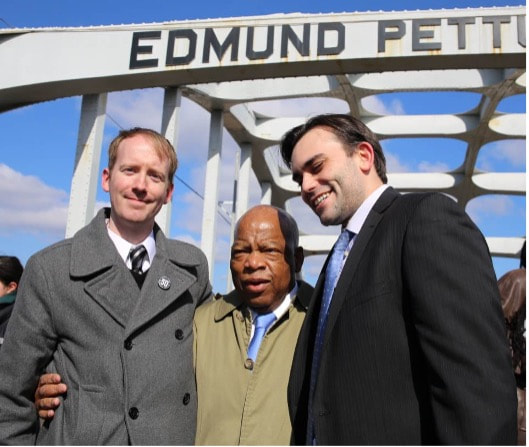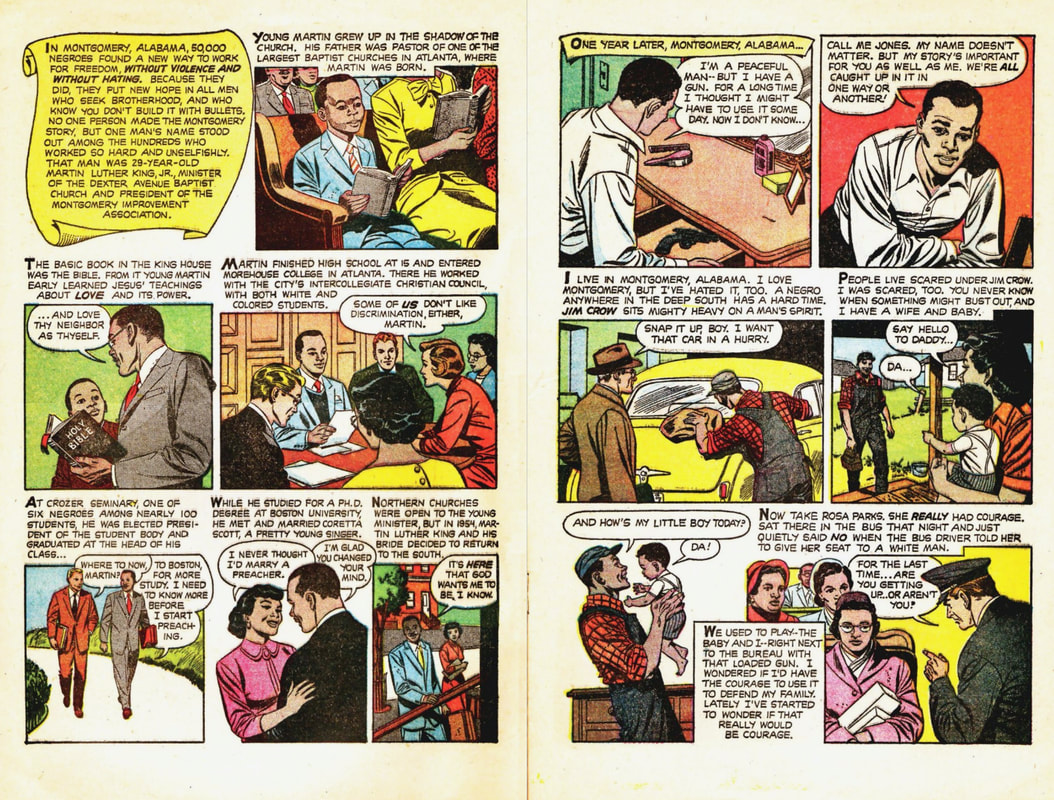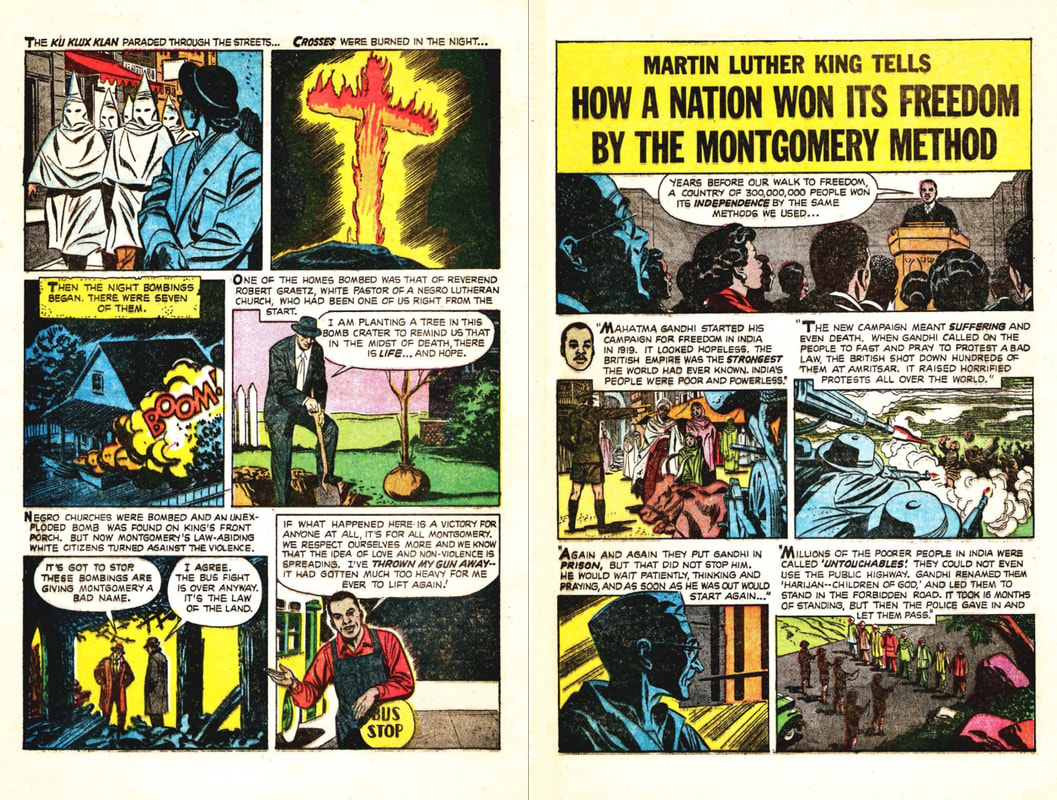Written by John Edward Betancourt  Key Art from ‘The Case of the Bleeding Wall’ Courtesy of Dead Sky Publishing. Key Art from ‘The Case of the Bleeding Wall’ Courtesy of Dead Sky Publishing. One of the best parts of being a nerd that geeks in these modern times, is the sheer respect that now exists for properties that we love. Because such respect has motivated some creatives to step up to the plate and put forth stories that smooth over injustices in long standing franchises, and it’s brought forth long-awaited sequels, and in the publishing world, it’s prompted a push to make sure that popular titles that sell out… find new life so that fans don’t miss out on great stories. As evidenced by what Dead Sky Publishing has done. For their wildly popular comic series, The Case of the Bleeding Wall, sold out quickly when it was first released, and rightfully so. Since it featured work from Bram Stoker Award-winning and Edgar Award-winning author Joe R.Lansdale (Hap & Leonard, Bubba Ho Tep) and his daughter, author/country singer Kasey Lansdale (Creepshow, Impossible Monsters), with illustration from award-winning artist Daniele Serra (Hellraiser, The Crow) and colorist Tom Napolitano (Swallower of Shades, Joker). But rather than just call it a day, and leave this brilliant saga, one that blended genres together, to memory… Dead Sky really has gone above and beyond. For they have released a Collected Edition of this saga into the world, so all can enjoy the cohesive nature and incredible stories within its pages, and well, to properly do this release justice, here are all the details upon it, and links to get your copy, courtesy of Dead Sky Publishing. ‘On September 20, 2023, Dead Sky Publishing launched the first issue of the comics series THE CASE OF THE BLEEDING WALL and it sold out immediately. Due to high demand for a second printing, it was reissued January 24 with a new cover from New York Times bestselling and multiple Eisner Award-winning comics creator Dustin Nguyen. The subsequent three issues sold out as well. Now all four issues of the series will be available in a beautiful quality collected edition, which publishes May 28. “It's important to us at Dead Sky to collect The Case of the Bleeding Wall because we want readers to discover Dana Roberts and Jana Davis for years to come,” Dead Sky Publishing editor and co-publisher Steve Wands. “With the nature of monthly comics there's a very narrow window of availability and that time has already passed. We hope readers that enjoyed the series come back for the trade, and that new readers can discover us, and their new favorite supernormal sleuths.” THE CASE OF THE BLEEDING WALL is the hit new comics series from Bram Stoker Award and Edgar Award-winning author Joe R.Lansdale (Hap & Leonard, Bubba Ho Tep) and his daughter, author/country singer Kasey Lansdale (Creepshow, Impossible Monsters), adapted by Kasey from their novel of the same title. They join forces with award-winning artist Daniele Serra (Hellraiser, The Crow) and colorist Tom Napolitano to bring you Dana and Jana—the new dynamic duo of supernatural-er, supernormal sleuthing. THE CASE OF THE BLEEDING WALL storyline: Dana Roberts, seasoned investigator of the supernormal, is called to Italy by an ex-lover to investigate a strange phenomenon—the mystery of a bleeding wall. She meets Jana Davis at a book signing event, and together they head to Italy in search of answers. Are they dealing with a haunted house? A demon perhaps? Or a vengeful specter from the other side? Dana has battled angry jinns, malevolent shadows, ancient travelers, and soul-sucking shapeshifters, but in The Case of the Bleeding Wall, she and her new sidekick, Jana, may face their most dangerous challenge yet. Here are three places readers can pre-order the book: Barnes and Noble: https://www.barnesandnoble.com/w/the-case-of-the-bleeding-wall-kasey-lansdale/1143801101?ean=9781639511648 Amazon: https://www.amazon.com/Case-Bleeding-Wall-Kasey-Lansdale/dp/1639511644 Walmart: https://www.walmart.com/ip/The-Case-of-the-Bleeding-Wall-Paperback-9781639511648/5333209926 Dead Sky Publishing, along with its Death’s Head Press imprint, publishes work that is inherently dark across a spectrum of genres and formats, in both fiction and non-fiction, from comic books to novels, from short story collections and anthologies to memoirs, and from art and photography books to graphic novels. Their books are distributed by Independent Publishers Group (IPG) and their comics are distributed by Diamond. You can visit them online at deadskypublishing.com.’
0 Comments
Written by John Edward Betancourt 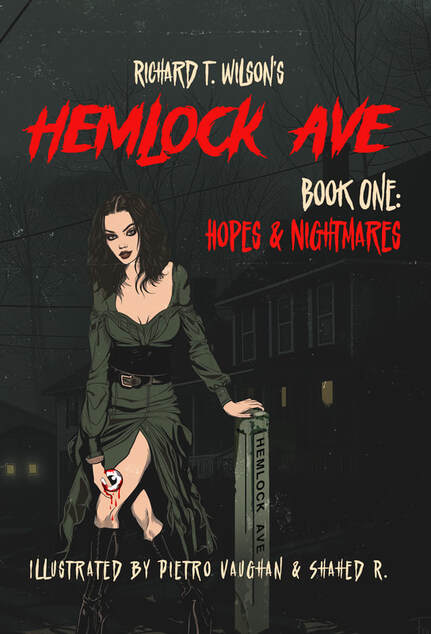 Cover Art for ‘Hemlock Ave Book One: Hopes & Nightmares’ Courtesy of Mad Shelley Comics. Cover Art for ‘Hemlock Ave Book One: Hopes & Nightmares’ Courtesy of Mad Shelley Comics. There was a time, where horror anthology comic books ruled the day, courtesy of E.C. Comics. Who released a pair of franchises entitled Tales from the Crypt and The Vault of Horror, that outright took the world by storm. For audiences were eager and ready to see what terrors awaited in these so-called funny pages and everywhere you looked, they were in comic readers hands. But alas, while they were important and iconic and dominant franchises, their staying power didn’t last, and they faded from popularity… but not from the hearts and minds of the fans. Because those stories influenced countless filmmakers and their structure and design influenced franchises such as Tales from the Darkside, and Crypt even managed to come to life via an HBO show. In fact, the love for these books and their unique style of storytelling has given them lasting power and influence well into the 21st Century. To the point where collected editions of those stories exist and where new iterations that embrace their spirit are finding their way to the marketplace. In fact, Mad Shelley Comics, and its prolific writer, Richard T. Wilson, are preparing to release their own horror anthology comic saga entitled, Hemlock Ave, and we here at NTG thought it would be worthwhile to share our review of Book One Hopes & Nightmares. Simply because… it’s a stellar read for so many reasons. First and foremost, because Richard manages to outright capture the spirit of what E.C. Comics and their brood stood for so long ago. Which is, stories that surprise and take us on incredible rides through the supernatural and the impossible and that is present here in spades. Since each story has something twisted and unique about it and goes places that you really don’t expect. Which gives rise to a real sense of nostalgia when reading this book. One that really does make you feel as though you’re a kid again reading such stories for the first time ever. Because of their purity and commitment to the core tenets of horror. Which is to scare, unnerve and outright offer suspense through and through. But while it is delightful to harken back to days gone by and double check the pages of this comic to see if the Creep from Creepshow is lurking about or if the Crypt Keeper will have a pun ready for you, it’s what Richard does with the stories that really makes this worth your while. For in many ways, Hemlock Ave. is a horror anthology for the 21st Century. Wherein some of the old devices you’d see in this kind of comic and even the genre, are missing. Replaced instead with the elevated concepts we find in horror now. So, that means you’re treated to tales of terror that are either quite grand in nature and feature things that go bump in the night, or you’re immersed in something that explores our internal fears. Such as our fears of a life not properly lived, which really is new to horror, but Wilson’s stories here handle such matters in a beautiful and haunting manner. Wherein we genuinely connect with the fear but press on with the story, since it’s obvious that Wilson has something to say on the matter and what is said is masterful in nature. In fact, there are great echoes of George Romero’s work here when it comes to the powerful stories that play out on the page. For this is a horror anthology that deeply explores the human condition and the corner of our mind that wanders into the darkest recesses of the soul at the most random moments of our day. Giving rise to an anthology that is very human in nature and very terrifying to say the least. And that writing, combined with the amazing art present from Pietro Vaughn, Shahed R., Katarina Naskovski, and Kevin McElroy brings forth something quite special. That rare horror comic that not only taps into all the primal fears we do our best to avoid but tasks us tackle them, so we can know the peace that the characters in these tales do not. Pre-Order ‘Hemlock Ave Book One: Hopes & Nightmares’ here. Written by John Edward Betancourt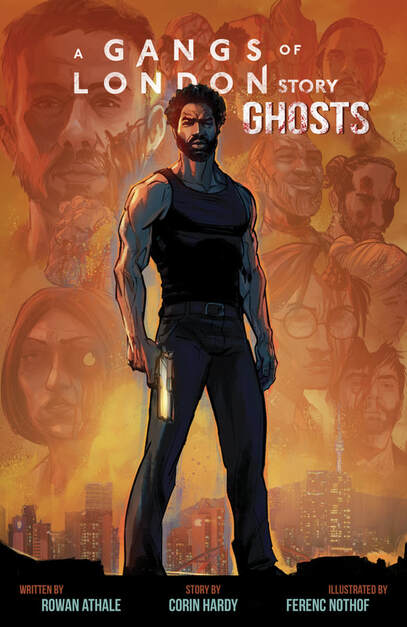
Truly one of the best aspects of living in this era of technological wonder, is that there is no limit to how stories can be told. Because if someone has a story that is nagging at them, they can create it via whatever medium they love and share it with the masses with minimal effort. And the big studios and networks are relishing in this freedom as well and using every medium imaginable to provide us with fresh new stories that captivate and titillate, and even the shows we love are taking the time to make use of this freedom to expand their grandiose stories even further.
Since webisodes and podcasts and even comics can also help to expand a universe and one particular show that is now taking advantage of this as well, is the AMC+ series, Gangs of London. For Lead Series Director Corin Hardy, saw an opportunity to turn to comics to fill in the gap between season one and season two and well… Corin has made that happen. For recently, A Gangs of London Story: Ghosts, a graphic novel that explores a time in Elliot’s life where he actually bothered to listen to the Investors, was released out into the world, and well, you can read that graphic novel right now, right here. Because Corin was nice enough to share a digital copy of the comic with us, so that we can in turn… share it with all of you! So, with that in mind here is that digital copy of A Gangs of London Story: Ghosts, and some details on the creation of the comic, courtesy of Mister Hardy. But do be warned! This is a comic that reflects the gritty nature of the show and is intended for adults and isn’t suited for younger readers, outside of that… enjoy! ‘GHOSTS is a new graphic novel with story by Corin Hardy, written by Rowan Athale and illustrated by Ferenc Nothof. Inspired by Gangs of London’s blend of grounded, emotional drama and graphic-novelized, heightened genre-heavy look, feel and tone, fans will get a greater insight into the characters and city of London that they have experienced on screen. GHOSTS follows lead character Elliot Carter, as he travels the world to carry out the orders of The Investors. Corin Hardy says: ‘I felt like there was a place for a natural companion to the episodes in the show, to tell a series of Gangs of London stories in graphic novel form, that will reveal further insights into our characters and what they get up to before, during and after season 2. I hope you enjoy the first of these, which picks up just before we meet Elliot in the second season and helps us understand the challenging consequences of the deal he made with the Investors and the emotional burden he carries with him....’ Written by John Edward Betancourt
It truly is quite the amazing time to be a fan of popular media and storytelling in general. Largely because, the internet and the streaming revolution have allowed for stories that would have lay dormant ages ago or be forgotten altogether, to come to life, and that is giving rise… to joy untold. Since we are connecting with characters that truly reflect our lives and our world and we are enjoying stories that are refreshing and original, and there are no bounds as to how those stories are being told.
It could be through a streamer, or a comic book or a company that opts to tell stories in an imaginative and unique manner, as is the case with today’s announcement. For earlier today, Macroverse, a web3 Entertainment company, let it be known that Evan Shapiro’s Darkland is coming to their platform on 12/6. Once again giving rise to a fascinating new way to experience original storytelling and an opportunity to enjoy a delightful new story and here are all the details on this release and Evan’s wondrous tale, and a trailer, courtesy of Macroverse. ‘December 1, 2022 (LOS ANGELES & NYC) —’Tis the season to collect comic books! Macroverse, the leader in digital digital comics, will launch Darkland, a twisted dark comedic drama set in Hell, created by Emmy and Peabody award-winning producer/creator Evan Shapiro (Portlandia, HarmonQuest) with the first full episode is available for all on Tuesday, December 6. Four new chapters will be released bi-weekly starting that Sunday, December 11 and available with a subscription through the next-gen Macroverse app. For those who want to be tempted and get a bite of the dark apple for free, new content will be available on Webtoons every Tuesday. Satan III is the ruler of Tyre (aka Hell) where his grandfather Satan I was killed trying to defeat Michael and the Archangels in a war for control of Earth. His son, the quite mad Satan II, was killed by his cousin in a battle for control of Tyre. And that is where our story begins. Satan III is embarking on a dangerous mission to take control of Earth from the Humans. Meanwhile, his cousin Samjaza has other plans - aligning with other Angels and Satan’s wife Zagiel, to take on a distracted Satan III and gain control of Tyre for herself and her Watchers. The Seven Princes of Hell and the rest of the Archangels play numerous games of multi-dimensional palace intrigue, and speed rounds of biblical espionage - all while cutting off heads, eating Humans for lunch, and finding time to quench their some truly disturbing appetites (being near deities does have perks). “Darkland is meant to have the look of Game Of Thrones, and the voice of Veep,” notes Shapiro. “Frank Calico’s artwork captures the tone 1000%, and Macroverse is the perfect platform to create a community for a new generation of comics.” “"Reading and collecting comics has been a part of my DNA for as long as I can remember,” said Macroverse co-founder Eben Matthews. “With Macroverse we are finally bringing comics fully into the digital age and delivering a cross-platform experience that I believe is the future of the art form. The Macroverse TapStory format brings new life to the medium while the Webtoons version is designed for quick and easy mobile reading. Early next year we'll bring real collectibility to digital comics with the release of the very first, fully formed NFT comics which is a breakthrough in collectible digital entertainment. It could not make me happier to be pioneering this with Evan and Darkland. This is a universe unlike anything out there. I can not wait to unleash this hilariously twisted story on the world.” A self-proclaimed comics fanatic since his early summers at camp reading Frank Miller’s Dark Knight, Darkland is Evan’s first comic book series. Until now, his creative (and warped) juices went into a long list of critically-acclaimed television series, documentaries, specials and podcasts all featuring original and diverse voices. Ground-breaking projects have included Portlandia, HarmonQuest, Comedy Bang Bang, Maron, National Lampoon Radio Hour Podcast, The Roast Of Your Teenage Self, Dinner For Five, Please Like Me, Take My Wife, Bajillion Dollar Propertie$, Shrink, Trapped In The Closet, Joseph Gordon Levitt’s HitRecord, Fortitude, Carlos, My Brother My Brother & Me, Brick City, This Film Is Not Yet Rated and Funny Women of A Certain Age and more. In addition to entertaining audiences, Evan is regularly cited by industry executives and journalists for his provocative takes on the entertainment landscape with detailed maps of the Media Universe. For more information about Darkland, please visit www.macroverse.com. Twitter: @darkland_comic; @MacroverseHQ Macroverse is a multi-format entertainment studio that rewards its community, collectors and creators for supporting upcoming blockbuster franchises spanning comics, TV, gaming, animation, movies and more. Starting with highly collectible digital comics crafted for consumption on any device, this next generation platform is positioned to reinvent comics for the digital age. Exciting new features launch in early 2023 with collectible NFT “Epic” editions featuring new work from Evan Shapiro (Portlandia, HarmonQuest), Jason Brubaker (reMIND, Kung-Fu Panda), Ariel Olivetti (The Hulk, Thor) and many more notable creators.’ Written by Juanita ‘Obi-Juan’ Bonner As we march through July (pun SOOOO intended!!) – the month for all things patriotic – it’s bittersweet to remember the passing of one the greatest patriots this country has ever seen – Congressman John Lewis (February 21, 1940, to July 17, 2020). Admirably, he spent his entire life fighting for equality and justice through peaceful and nonviolent means and those lessons should be shared with all who seek the same. For, without his contribution to the Civil Rights Movement and his political career that followed, there’s no telling where we might be today. Therefore, with education AND comics (of course…LOL!!) in mind, I’d like to take a look at the Congressman’s very own trilogy of graphic novels titled: March (Top Shelf Productions; IDW Publishing), that chronicle the tumultuous Civil Rights era. Beginning with a bit of background, take a seat at the front of the bus (*WINK*), or the head of the class as it were, and let’s get this journey started. BackgroundConvinced to create the comics by Mr. Lewis’ personal Telecommunications and Technology Policy Aide – Co-Author/Transcriber Andrew Aydin – the March Trilogy released as a series from 2013 to 2016. The reception was fantastic!! Everyone from politicians, academic scholars, celebrities and comic readers alike praised the works. All three books won various awards. Including the Coretta Scott King Book Awards (Books One and Three), the Eisner Award for Best Reality-Based Work (Books Two and Three), and the YALSA Award for Excellence in Nonfiction for Young Adults (Book Three). Book One also became the first graphic novel to win the Robert F. Kennedy Book Award in 2014. WOW!!! And let’s not forget the National Book Award in 2016 (Book Three) which was also the first comic to do so. This made the Trilogy’s Illustrator Nate Powell the first cartoonist to receive this prestigious honor. NICE!! And speaking of art… though all three books are in black and white, Nate’s powerful images and contrasts bring each page alive. Often using pitch black as a backdrop, the foreground is brimming with action that’s emphasized with white word bubbles and pictures. Grayscale and shadowing round out the ensemble bringing depth to larger shots like gatherings, Sit-Ins, protests, conflict, and violence and of course… the March! Quite honestly, because the covers are in color, it’s hard to believe the imagery inside isn’t the same. And in some ways, at least for me, the lessons within seem to hit that much harder in black and white. Symbolic of the struggle, the ink represents the human color divide while also delivering the messages within – in plain black and white. I wondered throughout if this dawned on the trio during creation. *Raised eyebrow* Further, using the March Trilogy Slipcase Edition for my review, I noted the outer shell is well crafted and the books themselves are beautifully made. Sturdy and thick. Each cover has folded in pieces with the same excerpt about Congressman Lewis inside the front flap and a summary of each book on their respective back flaps. The words: “To the past and future children of the movement,” are inscribed on the first page of all three which I LOVE!! And each holds the same touching Acknowledgments and About the Author sections along with a Praise portion that boasts awards, best seller lists and quotes of recognition. My favorite comes from Mr. Reading Rainbow himself, LeVar Burton, who says: “With March, Congressman John Lewis takes us behind the scenes of some of the most pivotal moments of the Civil Rights Movement. In graphic novel form, his first-hand account makes these historic events both accessible and relevant to an entire new generation of Americans.” Burton speaks immeasurable truth here! Why? Because from beginning to end, this Trilogy isn’t just a story. It’s history wrapped in truth and covered with art. It’s also told in a way that could be spread across an entire set of educational lectures surrounding the Civil Rights Movement. And it’s a way to dig deeper. Especially into the black experience. As we all know, US History usually glosses over this subject with some highlights and landmarks, but never really shows the true struggle. Particularly in the south. Even better, each book, though a continuing story throughout, is broken up into three major milestones within The Movement: Sit-Ins, Freedom Rides, and Voting Rights. All of which, told from Mr. Lewis’ perspective, do an excellent job of NOT hitting the highlights. He’s honest, not critical. Blatant, not rude. And finally, reflective without bias. A true patriot through and through!! Different from my comic reviews during 2022’s Black History Month of Rosa Parks and the Montgomery Bus Boycott and Martin Luther King and The Montgomery Story, the March Trilogy is likely best suited for young adults and above, rather than all grades. Especially if it were to be assigned reading. Additionally, many excerpts and pieces could be used to tie in discussions on Civil Rights, government and, of course, overall humanity. For all three books do not shy away from showing what true evil in the form of racism looks like. An experience EVERYONE should share, no? And with that said, let the lesson begin. Book One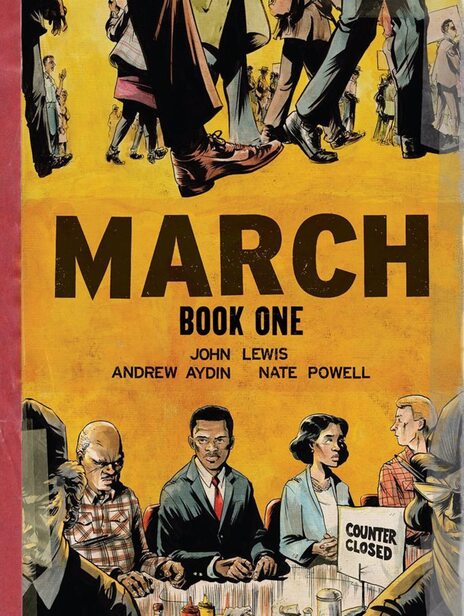 The shortest of the three, Book One opens with a preamble showing us a quick glimpse of the March itself – American Bloody Sunday (March 7th, 1965) – before jumping into the overall story. I don’t know about you, but virtually any recount of this day always strikes a sharp balance of fear AND hope in me. Seeing this right off puts you smack in the middle just for a moment. A few short pages later, you’re transported to January 20th, 2009 - Inauguration Day. At first, I was confused. Then I realized that this wasn’t like all the other Inauguration Days. This day would see the first African American sworn into office. A proud moment for people of color everywhere. *BIG GRIN* One that most certainly would not be possible without the events of Bloody Sunday. I mean, full circle in literally the first few pages is just… WOW!! Acting as an anchor of change and a breakaway from one section of story to another, pieces of the 2009 Inauguration Day are strung across all three books. Imaginative and apt, I love this!!! Diving back in… Mr. Lewis notes a missed call and voice mail on his cell. Moving on he wrestles with the cold D.C. morning and heads to Capitol Hill. There in his office, just before going to the Inauguration festivities, he’s interrupted by a woman and her two boys. Not expecting to actually see the Congressman himself, the mother wants her boys to see his office – a living piece of black history. American history! Of course, to their surprise, Mr. Lewis welcomes them in. I was instantly warmed by his unhurried demeanor. His loving embrace of the young black men. The pictures in his office. All of it. It felt like a blanket of love and a hot cup of cocoa… lol! And just like that, blending past with present the tale begins with John as a boy in Alabama. From preaching to chickens (LOVE THIS!!) and hiding from chores so he could go to school instead, John was by far not the average black farm boy. His calling came young and he never looked back. And once he heard the words of Reverend Martin Luther king Jr. on the radio, his life changed forever. From there, a series of events – the Brown V. Board of Education (pg. 53-54) decision, the murder of Emmett Till (pg. 57) and the protest from Rosa Parks (pg. 58) – set John on a path for justice. One that grew from giving his first sermon (aside from the chickens of course… LOL!) just before he turned 16 years old into helping found and grow the Student Nonviolent Coordinating Committee (SNCC; 1960-1971). It’s awe inspiring to say the least. But what Book One does best is walk the reader through the history of Sit-Ins. It’s here that we see small town racism escalate to the field of big politics. Yet, it’s the counter-side images and commentary that’s most impactful. I repeatedly had to step outside the story to remind myself that this was real life. That segregation, just like its brother, racism, run deep!! Even today… right now… it’s horrific to think EVERYTHING I hold dear could be destroyed by any given white person simply because of the color of my skin. Back then, Sit-Ins were the tip of the iceberg and Mr. Lewis makes it clear why they were just the beginning of the fight for equality. A part of history seldom discussed in the average history class… or anywhere else for that matter. Heck, besides this book, the only other graphic depiction I’ve seen of Sit-Ins comes from Season 2 of The Umbrella Academy (Netflix; 2019 to present). Finally… in the 21st century, these stories are being told away from a white-washed narrative and I LOVE IT!! Bravo to both mediums! As one would imagine, segregated lunch counters across the south resisted. So did political figures and Washington… for a time. But in the end, no one could stop the winds of change and like the Bus Boycott, Sit-Ins prevailed. Using non-violence and the lessons of The Montgomery Method – also taught via comics… YES!! – segregation began to slowly disappear. From there, Mr. Lewis and his brethren marched on and right into the next movement – The Freedom Riders. Book Two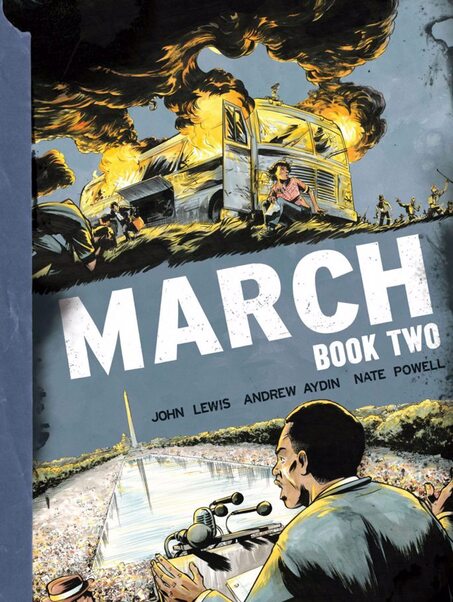 Book Two opens with a small piece of the Inauguration celebration before leaping right into the fight for justice. Turning his sights from lunch counters to restaurants and movie theaters John lands in jail… again! In fact, he spent his 21st birthday behind bars. *WOW* By 1961, following the Boynton V. Virginia ruling (1960) – “which outlawed segregation and racial discrimination on buses and in bus terminals (1)” – Freedom Rides began to take hold. Wanting to initiate something similar himself under SNCC, but denied due to the danger, John notes that when he saw the ad from the Congress of Racial Equality (CORE) for volunteers to join “Freedom Ride 1961 (2),” He felt: “It was the spirit of history at work again. (3; pg. 30)” Indeed Mr. Lewis… INDEED!! From there the reader is immersed in the scary history of escalating racial tensions, missing activists and senseless acts of violence. Racist to the core governors, mayors, police and countless public officials stand in their way. Riders are beaten, including Mr. Lewis, and some were even murdered with no consequences to the perpetrators. One – Dr. Bergman – was beaten so badly: “He sustained permanent brain damage and a stroke that would paralyze him for the rest of his life (pg. 52). *SIGH* Unfortunately, even before the Freedom Rides, this was the norm in the south. And like Book One, the black and white images are jarring and frightening. Simply put, aside from the depicted violence, seeing a shadow of hoods is even scarier. Knowing people go missing for simply standing up for their Constitutional Rights is worse. And finally, understanding that ALL OF THIS is based solely on a different skin color is wholeheartedly and breathtakingly sad. But the violence doesn’t stop there. There’s even more to be had when the story moves into the fight for the right to vote. A part of history that is by far not discussed enough. Though these comics came out well before, in the wake of the "Big Lie” surrounding the 2020 Election, it’s shocking to read what my fellow black brothers and sisters had to go through to simply cast their vote at all. Sure, I’ve heard the stories and have even studied it a bit while pursuing my Minor in History many years ago. But all of that pale in comparison to Lewis’ story and Powell’s images. Maybe it’s because I love comics and seeing something so real in comic form hurts more. Maybe the real life still shots of voters in line or holding picket signs aren’t jarring enough. Or maybe… and my money is on this one folks… WE as a Nation, without an extensive overhaul of US History… have NO IDEA how important that time was to the Democratic process. Our eyes are closed to the plight, the right and the fight for the black vote. Hence why it lives in peril to this day as massive voting rights legislation – including the John R. Lewis Voting Rights Advancement Act of 2021 – is ignored in favor of restricting ballot boxes and poll centers in communities of color throughout the country. *SMH* Anyone who says racism ended with Barack Obama are not only lying to you, but to themselves. Often times, on purpose! Yep, I said it!! Thankfully, our authors take care to use the anchor and continually mix in uplifting images from the 2009 Inauguration. Another of many full circle moments, the post card from Obama to Lewis inscribed: “Because of you John (Book Three; pg. 189),” is particularly touching!! And each victory, no matter how small, is joyous. In contrast, the defeats are jarring. Particularly when children are involved. Overall, emotions run heavy throughout. As for John? By the end of Book Two, he’s become the SNCC Chairman, is now included as part of the Civil Rights icons known as the “Big Six,” and spoke at the 1963 March on Washington. And he’s only 23!! HOLY COW!! From the beatings and arrests to accomplishments and triumphs, it’s hard to believe how much this one man endured. Even with all that hope, Book Two closes with just a couple pages surrounding one of the darkest times of Civil Rights history - the 16th Avenue Baptist Church bombing in Birmingham, Alabama. *SIGH* And still… we MARCH!! Book Three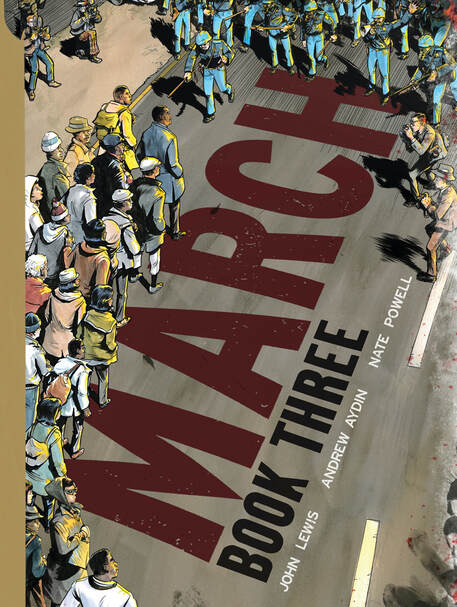 The thickest of the Trilogy, Book Three wastes no time letting us know the stakes with a grim preamble showing more details on the church bombing. A lady opens the bathroom door to find four young girls inside. As she hurries them along from Sunday School to the main Service (pg. 5), my heart sank. Taking me sharply back to that horrific feeling of harm simply for the color of my skin, the next few pages, as well as so many other sections throughout, reveal how right I was. How sad. How… ANGRY!! Following the horrific church bombing, the protests that escalated were equally matched with opposition and violence. Still, we marched! The Movement grew as more and more African Americans decided to exercise their constitutional right and register to vote. Intimidation, discrimination and outright cruelty pushed back. Folks stood in line for hours without food or water and anyone attempting to service them would face arrest for interference. And the majority who actually made it in to register were often denied due to ridiculous rules and racist public servants. Yeah, I said PUBLIC servants!! *SIGH* It was said the conditions matched that of “South Africa under Apartheid,” which in turn sprouted similar efforts to educate in the form of the SNCC organized, Freedom Vote (pg. 44). *HECK YEAH!* The mock elections – held the same time as Mississippi state-wide elections – allowed black voters a chance to see how and where their vote, or lack thereof, mattered. Ingenious, I say!! Something we need more of TODAY!! Digging deeper. By the time John F. Kennedy was assassinated (November 22, 1963) racial tensions were at an all-time high. In the summer of 1964, the mock Freedom Vote morphed into the Mississippi Freedom Democratic Party (MFDP) which went beyond education by: “going after real voters (pg. 65).” Yet, After three volunteers – Mickey Schwerner, Andy Goodman and James Chaney – went missing, things seemed hopeless. However unfortunate, “The incident provided the final impetus needed” for Kennedy’s successor Lyndon B. Johnson (LBJ) to sign the Civil Rights Act into law (July 2, 1964). However, not unlike other volatile times in history, political party ideology was in major flux as Democratic defectors (Dixiecrats) moved to the Republican Party where the platform has remained to this day. As if politics didn’t play a major role before, they most certainly were front and center now!! Ripple effects at the 1964 GOP National Convention, saw the Republican Party reject Nelson Rockefeller and back Barry Goldwater for President. The Democratic National Convention was equally disruptive with the MFDP pushing for black representation in Mississippi’s all white Democratic Party Delegation. It’s still shocking to me that even after the nationally televised testimony of so many, including MFPD Vice Chair, Fannie Lou Hamer, the MFDP lost the vote. A sad turning point in the fight for sure!! As Mr. Lewis put it: “Lingering feelings of cynicism, mistrust of government, and deep resentment of ‘white liberals’ would cast shadows over southern politics for decades to come (pg. 126).” *FACTS!!* For John, a reset was definitely in order and after an eye opening educational trip to Africa, John came home to an SNCC in disarray. The adopted African anti-colonial mantra of One man, One vote (pg. 33) was collapsing under its own weight. Working to keep things together, the pressing issues surrounding the right to vote continued. With so many nuances, it’s hard to tell where one mission ends and another one begins. Still… we MARCH! Around the time Malcolm X was assassinated a protestor and Vietnam veteran named Jimmie Lee Jackson was shot after fleeing attack by officers at a night vigil. He passed away from his sustained injuries shortly after Malcolm X. *SIGH* During Jackson’s funeral, it was said that his casket should be taken from Selma to Montgomery and laid at the Capitol steps (pg. 182). Thus, the idea for the March was born. *WOW!!* The weight behind this one idea is just… As the final 60+ pages (YES, 60!!) unfold, I was filled with so many mixed emotions. Transported back to the beginning of Book One, the March and subsequent brutality on the Edmund Pettus Bridge, is shown. The calm nature of the March is disrupted by racial slurs and outright violence. Mr. Lewis along with others are beaten. Only this time, the events are shown LIVE to MILLIONS on television causing a swell of support. YES!! Rallies and protests erupt across the nation. LBJ gives what Mr. Lewis calls: “One of the most moving speeches I have ever heard an American President give on Civil Rights (pg. 224).” *WHOA* Then Federal Judge Frank M. Johnson Jr. – a proven ally in the Movement – lifts the injunction against the March. Alabama Governor George Wallace loses the fight!! *FINALLY* By the time the third and final Selma to Montgomery March begins – just two weeks after Bloody Sunday – the tide has turned. Upwards of 25,000 people participated in the 54 mile trek, including John, who was still recovering from a skull fracture he received on Bloody Sunday. He traveled to and from hospital care in Selma for monitoring during each stop on the March (pg. 232). *HOLY COW* At the end, a huge celebration with a concert organized by Harry Belafonte ensued – “A salute to Selma (pg. 233).” *NICE!!* And by early August, the Voting Rights Act was signed into law. Yet, even with all that, sadly, violence, opposition and murder continue to this day. Heck, Governor Wallace – famous for his 1963 “segregation now, segregation tomorrow, segregation forever” inauguration speech – remained in office into the 80s folks!! Thankfully his presidential aspirations never came to fruition. *WHEW* But change is possible folks!! Much later in life, following a failed assassination attempt which left him paralyzed, Wallace changed his stance and sought to reconcile with black voters and Civil Rights leaders, including Lewis! Of course, Mr. Lewis forgave him. Regardless, the racial struggle in this nation and around the globe are ever present and still… WE MUST MARCH!! The comic ends with John settling back in at home after Inauguration Day. The list of missed messages has ballooned to twenty-eight in total! The reader is privy to the first one mentioned at the beginning of our voyage. Ted Kennedy! He reminisces about all he’s been thinking about leading up to this day. “The years of work and bloodshed… the people who didn’t live to see this day (pg. 245).” Jack, Bobby, Martin. *WOW* My heart sank… again! I take a deep breath and turn the page. It’s the next day AND the last page of our journey. John surprises Andrew Aydin by telling him he's ready to make the comics. *BIG GRIN* And just like that, my hope returns. Thank you, John! *WINK* The End. Final ThoughtsOverall, I really can’t say enough about these comics. They showed me things I truly was not aware of about The Movement. Things that a white-washed history doesn’t talk about. Heck, right now… to this day… a well-respected source for digital history knowledge, History.com, always makes the top of searches, and one I’ve linked in this article, hits JUST the highlights on their page: Civil Rights Movement Timeline. Of course Bloody Sunday is included, as well as Sit-Ins and Freedom Rides. But where’s information on the missing Freedom volunteers? Voting intimidation? Fannie Lou Hamer’s testimony and so, so, so much more? True, there are links to more information at the bottom of the page as well as many other sources to be found. And when you search the individual incidents, History.com also has many separate pages. However, you literally have to be looking for the information. It’s just simply NOT included in the timeline. Several others are no different with some not even mentioning the SNCC at all. *WTF* Martin Luther King Jr. (SCLC President) is the face of The Movement overall which in many ways, given his elevated public notoriety, is understandable. However, when teaching history, John Lewis and countless others, sadly go overlooked, even now! Not to mention the ties to black oppression in Africa, the links – and often times, lack thereof – between the different Movement organizations (SNCC, SCLC, NAACP, CORE, etc.) in the states AND the multiple political diversions along the way. Including from LBJ himself!! *SIGH*
On a much lighter note. The forces behind Congressman Lewis’ comics – Andrew Aydin and Nate Powell – are so proud to be there. In discussions, videos and print. It shows! The work is spectacular and the awards well deserved. As evidenced in this lovely interview via Comic Book Review TV (CBR-TV) at San Diego Comic Con in 2013, putting these comics together was a wonderful marriage of fanboy love and professional respect. And, as far as education goes, there’s so much in these books that one could pour over them repeatedly and still find something new. Heck, I’ve barely scratched the surface in this article!! The history is raw and despite being in black and white, quite colorful. But what really got me was seeing Mr. Lewis – during promotion for the books at San Diego Comic Con in 2015 – cosplay as himself from Bloody Sunday. Recreating the moment with a symbolic AND peaceful march (just like in 1965), Congressman Lewis led a group around the Con with the numbers swelling throughout. The images and videos of the event are absolutely touching and quite literally make me teary eyed every time I look at them!! When Mr. Lewis passed, an overwhelming support of love and grief filled all forms of media. A personal favorite is this video clip where Stephen Colbert celebrates John’s life. The video itself is full of love and respect but a quick summation of the man John Is, comes when he explains (3:21 mark) how he forgave one of the Klansman who beat him in 1961 during a Freedom Ride after the man came to his Congressional Office in Washington with his son and apologized. They hugged and cried together. I mean… if you take NOTHING from this whole article, along with his forgiveness towards Governor Wallace, take THAT!! Congressman Lewis, the humble caring soul he was, sheds no spotlight on himself in these books. Instead, he gives praise to all sorts of people who took part in The Movement. He also doesn’t shy away from mentioning organization infighting and clashes between faces of The Movement as well as his personal feelings on various issues, fellow fighters and political figures. All with grace and awe inspiring dignity. He’s also on record, including in the comics Acknowledgements section, praising Co-Author Andrew Aydin and Illustrator Nate Powell. Because just like all his other work, Mr. Lewis knew that no one does it alone. And with that, I’ll say “Good trouble… necessary trouble,” always NEEDS allies!! Rest in Power Mr. Lewis, for your March is done. Until next time… remember, History matters to us all!! Written by Zeke Perez Jr. 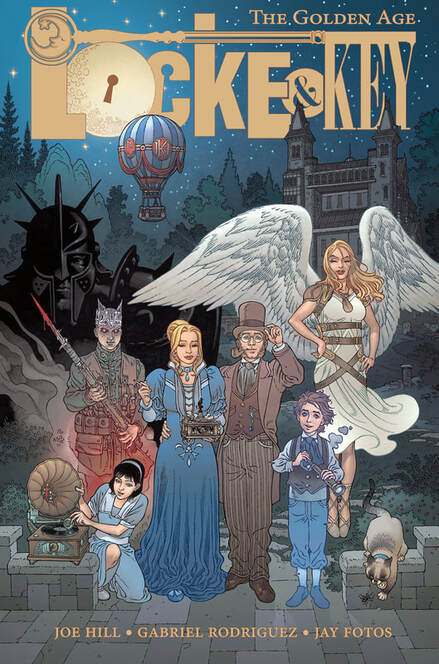 The newest collected edition of the Locke & Key series arrives in an astounding hardcover on April 26th - and it’s a must-own for longtime fans of the franchise, for folks looking for more backstory and detail on the Locke family, and even for newcomers who enjoy fantasy and horror. I personally fell into the latter category when I read it, but Locke & Key: The Golden Age provides so much content, depth, and stellar artwork that not only did I feel up to speed, but it left me wanting to dive further into the Locke world. The Golden Age collected edition from IDW Publishing brings together work spanning over a decade from writer Joe Hill and illustrator Gabriel Rodriguez. It has a lot to offer, featuring a variety of narrative styles as it includes two short stories (“Small World” and “Open the Moon”), a complete three-part miniseries (“...In Pale Battalions Go…”), the two-part crossover with DC Comics’ Sandman Universe (“Hell & Gone”), and an exclusive, previously unpublished short story from Hill and Rodriguez (“Face the Music”). It also boasts dozens of variant covers and art designs from across the included issues. Locke & Key centers on the Locke family, stewards of Keyhouse for over 200 years. Keyhouse, a New England mansion with a magical history and many reality-altering keys with their own unique powers, has new trials and secrets that come to light. The stories within this collection focus on Keyhouse in the early 20th century, as the Locke family ancestors use the keys in World War I battles, ultimately opening a sinister door between two worlds. The “Small World” and “Open the Moon” prequels serve as great character development and set the stage for the power of some of the keys. “Small World” is a little lighter, yet still a fun adventure and a great look into some family dynamics. “Open the Moon” is much more poignant and emotional. The third short story, “Face the Music”, is a fascinating addition to the book, especially for longtime fans of the franchise. The tale introduces the Orchestra Key in a whimsical storyline. The background of how “Face the Music” came to be is intriguing in its own right: it developed as part of a vinyl record project that Hill and Rodriguez were working on. That project never came to fruition and the short story was never released there or as a single issue, so fans can see it for the first time in this hardcover. The tone of the collection turns grim and bleak as it moves into the war storyline of “...In Pale Battalions Go…”. The story challenges the ideals and motivations of the Locke family, as John “Jack” Locke attempts to use the keys to participate in World War I and to do his part to defeat evil. Unfortunately, a ripple effect is ignited with dire consequences for the future. That carries us into “Hell & Gone”, the crossover with Neil Gaiman’s Sandman Universe. There, John’s brother Mary must try to make right by the family to set things straight for the future. The jump into the Sandman Universe and the inclusion of its characters vastly broadens the impact and scope of the Locke’s world. The talents of Hill and Rodriguez are on full display in this collection. The stories that are included balance each other out well emotionally, as well as in length and style. The writing meshes well into the broader DC and Sandman Universes. The art perfectly fits the world and the story being told too, as Rodriguez’s depictions of people and of the horrors they face are realistic and chilling. Together, the writing and art perfectly marry horror, fantasy, speculative historical fiction, and mystery. It’s pretty rare that a collected edition can be a culmination of many years of work while still taking the story into uncharted and bold territory. It’s also rare that a collection can feel familiar to fans of the series after so many preceding story arcs, but still feel like a great entry point to new readers thanks to all of the character development and backstory given in the prequel issues. Locke and Key: The Golden Age accomplishes all of the above and more. As someone new to these stories and universes, I can’t wait to read more. I can only imagine what this collection will mean for fans who have been with the Locke family since the beginning. Nerds That Geek Comic Book Review: ‘Moon Knight’ (2006) No. 20 – ‘In the Company of Wolves’3/23/2022 Written by Joel T. Lewis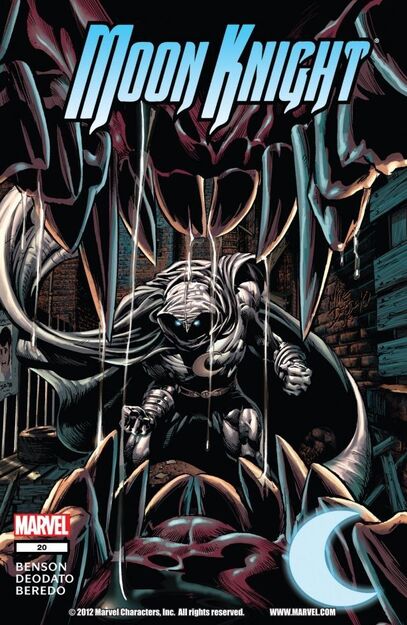 In celebration of the upcoming release of the Moon Knight series premiering March 30th on Disney Plus I’m doing a deep dive on some of the lesser explored corners of the Moonie Mythos. This time we’re taking a look at a good old fashion Moonie VS Werewolf by night spectacular. It’s brutal, it’s animalistic, and it’s oh so glorious. “In the Company of Wolves” written by Mike Benson and illustrated by Mike Deodato Jr. Driven literally underground by his very public murder of Black Spectre, Moon Knight recalls an unexplored encounter between himself and his oldest comic book adversary: Jack Russell, the Werewolf by Night! Jack Russell, the werewolf by night, is captured and forced to share his deadly curse with the unsuspecting foot soldiers of a high roller’s blood sport ring. His handlers collect his blood to temporarily give the unwitting human competitors the strength and appearance of werewolves. Meanwhile, Detective Flint and Moon Knight investigate a string of bloody murders, thought at first to be the handiwork of an overzealous new serial killer. It quickly becomes clear that the gory evidence left behind at the crime scenes is the work of something big. And clawed. So, Moon Knight investigates a nightclub called the Lu’Pine after gathering intel as the cab driver Jake Lockley and discovers the nightmare dog-fighting ring hidden below. Moon Knight frees the captured competitors, setting them on their captors and discovers that the temporary lycanthropes, while viscous, don’t hold a moonlit candle to the genuine article. Freed by the full moon’s light, Jack Russell towers over Moon Knight in his animalistic form and the caped hero and Marlene work to bring the big wolf down. Blurring the line between man and violent beast himself, Moon Knight defeats the werewolf but spares the man, allowing Russell to escape his cruel incarceration. 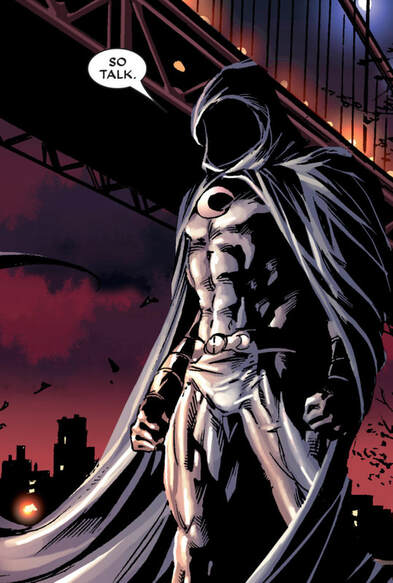 All due respect to Mr. Benson, but this one is all about the art for me. When you start a run with a talent like David Finch, you establish a different level of expectation for a book’s artwork. Mico Suayan maintained the style and tone of the book skillfully after Finch departed and Tomm Coker gave us the haunting grit of issue 13, but when you get a rip, tear, slash-fest script featuring the Jet and Silver Avenger and his first foe and Mike Deodato Jr. is on the job, well that’s something special. Claws, viscera, muscle, sinew, bone. These have got to be a few of Deodato’s favorite things. With multiple excellent Werewolf designs and carnage teasing the wild final clash between the massive Jack Russell and our hero, Deodato runs wild in this issue. Deodato’s Moonie design sports a massive billowing cape that just dances out of the panels. The waves and creases in the cape evoke broad dramatic motion even as the Fist of Khonshu stands still showcasing Deodato’s masterful character work. Look, I love it when Moonie crosses crescent darts with Bushman, Stained Glass Scarlet, and Morpheus as much as the next guy, but the main event of Moon Knight matchups is always going to be Werewolves for me. They share a common inspiration in the full moon, they both have aspects of themselves they can’t control or repress, and they represent insatiable appetites for carnage. This is one of the rare Werewolf storylines in the Moon Knight canon, one I recommend highly, and if you happen to find a copy in your local comic shop, you’re in for a treat: the issue includes reprints of Moon Knight’s first appearance in Werewolf by Night 32 and 33! Written by Joel T. Lewis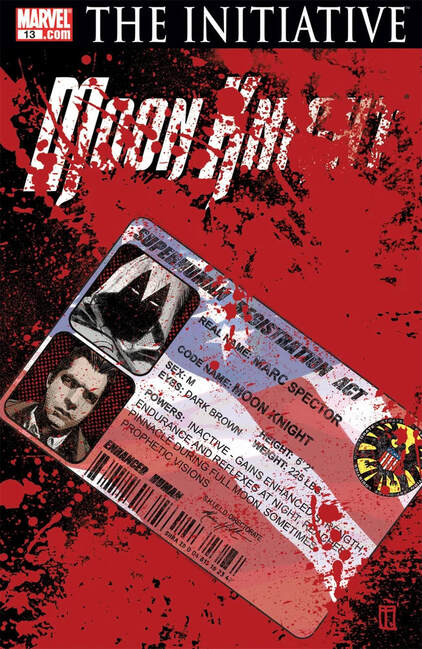 In celebration of the impending release of the Moon Knight series premiering March 30th on Disney Plus I’m doing a deep dive on some of the lesser explored corners of the Moonie Mythos. This time we’re taking a look at Moon Knight’s admission as a card-carrying member of the Avengers and this time, it’s not on the West Coast, and it’s no Secret, “The Uses of Restraint” written by Charlie Huston and illustrated by Tomm Coker. Moon Knight’s neutrality in the Civil War is a problem for everyone. Occupying no man’s land while flooding Detective Flint’s office with crippled cons with crescent moons carved into their foreheads, neither side wants the jet and silver wraith. Worn down by Khonshu’s unslakable bloodlust, Spector decides to try to secure a place as a member of the Avengers, the main obstacle? He has no hope of passing the psych eval. Moon Knight recruits the bottom feeding manipulator The Profile to assist him in terrifying his evaluator into rubber-stamping his application. I love the interplay between Marc and Dr. Depford, from the doctor’s initial condescending dismissal, to the moment you think Khonshu is possessing Marc and interrogating the interrogator, to the revelation that even though it’s the Profile instead, it’s no less cool because Marc knew he could do that. 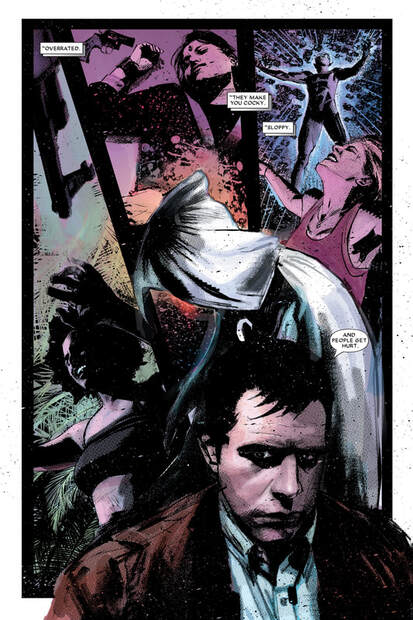 This issue is dark, gruesome, twisted, and no good place to start reading about the Civil War Event, however it shines light on Moon Knight’s ingenuity and cleverness in manipulating people’s perceptions of his madness. Though his Dissociative Identity Disorder (DID) is not very thoroughly explored in this particular run, Marc’s mental illness and hallucinatory projections of Khonshu inform the visual style and perspective of the reader in this issue beautifully; twisting and distorting our expectations as Marc completes his mission. This issue traces the dark tendrils of Marc’s social circle quite atmospherically. Isolated and alone once again though he is, the darkness of his mission, and the violence it demands continues to echo in his loved ones attempts to move on as Marlene is bored by her new fling, and shocked at how easily violence (and vengeful violence at that) comes to her when they are attacked on the street. Frenchie longs to be by his friend’s side, trying to balance his unrequited love, his disgust and trauma. Marc’s duty as the Fist of Khonshu can have no competition, and anything that tries to temper that mission of vengeance, ends up crushed inside that fist. My favorite issues of Moon Knight are always those that explore the complexity of the character, and I love the way this one characterizes the extent of trauma that Moon Knight causes and his self-awareness and tenacity in the face of his earned isolation. Marc is ever-broken, and Huston’s view of the shattered pieces of his psyche is fascinating. 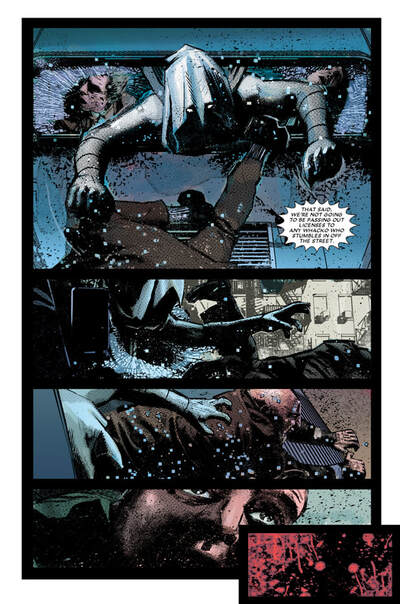 I also love that in this issue Marc says definitely, “I don’t have powers.” As much as I love the early origins of Mark being bit by a werewolf and having strength that’s amplified based on the phase of the moon, it’s so much more interesting when Marc doesn’t have powers. As psychedelic and alien as Marc can seem in these comics, I’ve always thought having no powers made the extraordinary things he could do that much more remarkable. More noteworthy still, Huston’s characterization acknowledges that Marc used to have powers, used to slip into his alter-egos, and is now coping with repressing them, and losing those powers. Huston’s Moon Knight bears the scars of all his incarnations, and it’s such a brilliant extension of the character’s depth, and the depth of the damage to his psyche. Tomm Coker’s newspaper pulp style art is one of a kind in the pantheon of Moon Knight artists, especially his flashback panels which evoke the work of Chris Warner and E.R. Cruz and Bill Sienkiewicz while also maintaining a style all their own. The implied and applied grime in these panels, and the lithe, almost ghostly depiction of Moon Knight matches Huston’s tone perfectly. Moon Knight’s story set against the Civil War backdrop is such a great setting to explore his place in the superpowered community, and how he must carve out a space for himself because as a hero, he’s never fit the mold. This issue is a great snapshot of the character’s history, his impact, and his potential for interesting storytelling and I hope you all get a chance to read it! Written by Joel T. Lewis 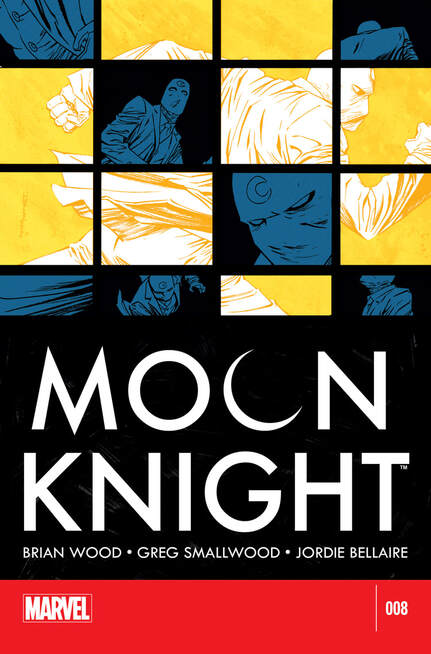 In celebration of the impending release of the Moon Knight series premiering March 30th on Disney Plus I’m doing a deep dive on some of the lesser explored corners of the Moonie Mythos. First up is an experimental and chilling issue first released in December of 2014, issue number 8 “Live” written by Brian Wood, and art by Greg Smallwood. Responding to a suicide bomber seizing control of the One World Trade Center building in New York, Moon Knight coordinates with Detective Flint to scale the skyscraper and liberate the hostages, imprisoned high above the police presence and media frenzy below. We follow Moon Knight through the lenses of camera phones, local news coverage, scarab spy drones, and security camera footage as he coordinates his dissociative identity disorder alter egos to infiltrate and neutralize the hostage situation. Transitioning from affable negotiator Steven Grant to the terrifyingly efficient brutality of Jake Lockley this issue explores the potential strategic dominance Moon Knight is capable of, provided he can get his alters to cooperate. While the completion of the mission rapidly spirals away from the civility of the rules of engagement, Marc is self-aware enough to tell Flint to contact his therapist. This signals his own instability and desperation for an anchor but also puts his therapist, whose motivations are in question at this point in the run, on Flint's radar as he (Marc) suspects her to not have his best interests at heart. In a series famed for the incredible artwork of Declan Shalvey (who adapted the now iconic Mr. Knight design from its first introduction by artist Michael Lark in issue 19 of 2010’s Secret Avengers series), Greg Smallwood (who would become the series regular artist for Jeff Lemire’s 2016 run) plays with form and expectation with his interpretation of Moon Knight in issue 8. “Live” is a brilliant, shocking issue which challenges the conventions of comic book art, scripting, and lettering by emulating mediums of modern technology. Smartphone screens, texted dialogue and narration, and security surveillance footage stand in for the traditional panel and speech bubble staples and the effect is stunning. This an issue that pushes the boundaries of comic book storytelling which in many ways is a Moon Knight tradition. Harkening back to the brilliant evolution of Bill Sienkiewicz’s art in the first Moon Knight series in 1980, (specifically issues 23-26) this issue uses every ounce of its creators’ ingenuity to capture the Jet and Silver Avenger from unique angles (pun intended). 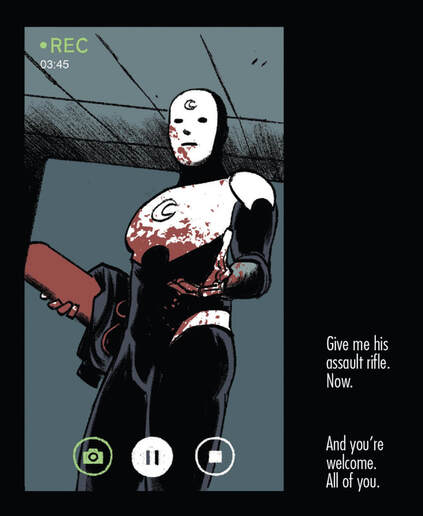 The haunting images of a cloak-less Moon Knight, stalking the darkened cubicle aisles of the high-rise he’s scaled are eerie, casting our hero as an enigmatically sinister crash test dummy instead of righteous savior. The uncanny valley at work is two-fold: the inhuman, vacant expression of Marc’s mask fails at appearing human, but it also fails at appearing to be Moon Knight. The design is terrifying, and I wouldn’t be surprised to see it reprised one day as a villain’s chosen costume (perhaps a Moon Jester to trade blows with our Moon Knight?). Moon Knight’s madness and brutality are at their most infamous and extreme in the 2006 Huston and Finch run “From the Bottom” in which we see a vicious fist of Khonshu carving crescent moons into the foreheads of his criminal victims, and most famously of all cutting the face off his oldest enemy Raoul Bushman and wearing it. This issue has to become part of that conversation. The rage, the cold tactical planning and coordination of Marc’s alters (alternate identities) in this issue, and the casual menace of Jake Lockley’s crippling and later bloody murder of the would-be suicide bomber plunge this characterization of Moon Knight into its darkest iteration to date. This is an unpredictable, competent, and brutal individual and if you have the misfortune to meet him there’s a good chance you’ll have to fight to stay a-“Live”. Written by Juanita ‘Obi-Juan’ Bonner  What comes to mind when hearing the words Civil Rights? For me, I’m immediately flooded with multiple images. Mostly of black and white photos and videos from the 1960s when color had a strict line matching those very same depictions – black and white. Sadly, from post-Reconstruction (1860s) well into the 1950s, Jim Crow was the law of the land making racial segregation commonplace in the south. Further solidified by a Supreme Court decision, Jim Crow dominated virtually unopposed for nearly 100 years (1877-1954). WOW!! Thanks Plessy v. Ferguson (1896)!! *Insert eyeroll here* Though reversed by the Brown v. Board of Education decision in 1954 (*YES!!), the lasting effects of Jim Crow still linger today. As for those images?? I not only see them, but FEEL them too! For they’re not only African American history. They are MY history and to a greater extent, American history. Rich with strife yet full of glory and triumph as well. And in 1955, one Rosa Parks grabbed some of that glory and changed the course of OUR history forever when she refused to give up her seat in the ‘Whites Only’ section on a bus in Montgomery Alabama sparking the monumental Montgomery Bus Boycott. *ROARING APPLAUSE* I covered Rosa and this event in my comic review: Rosa Parks and the Montgomery Bus Boycott and today, I’d like to expand by discussing one of the most prominent figures of the Civil Rights era – Dr. Reverend Martin Luther King Jr. – and how his own little comic helped ignite movements for change. So, let’s take a closer look at: Martin Luther King and The Montgomery Story, shall we? Published in 1957, only a few short years after the Montgomery Bus Boycott, Martin’s comic was conceived at a time when comics themselves faced vilification. Spearheaded by the German psychiatrist Fredric Wertham (1895-1981), the comic book industry came under scrutiny in the 1950s for violent imagery and childhood corruption. I mean… the Cold War era, am I right… LOL!! This led to a Congressional inquiry that later produced The Comics Code of Authority in 1954. But none of that stopped Alfred Hassler (1910-1991), the Publications Director at the Fellowship of Recognition (FOR) – “A global movement founded in 1914 to support the rights of conscience in resistance to war and military conscription.” Ironically, Hassler didn’t even allow his own children to read comics (*THE HORROR!!* – LOL!), but firmly believed in: “The medium’s value in reaching a different, younger audience than a conventional book.” Thus, penned by Hassler and Benton Resnik and inked by Sy Barry, The Montgomery Story was born. Dr. King also provided editorial commentary that was directly added to the final product. *NICE!!* Spanning the country and eventually the world, the 16 page comic inspired multiple movements in and out of the US, including anti-apartheid and Arab Spring protests. HOLY COW!!! I certainly didn’t know that going in, but boy am I damn proud to know it now!! *BRAVO!* As for its contents? Unlike the Parks comic, The Montgomery Story is structured more like traditional comics. There’s no table of contents or bibliography as with Rosa’s book. And with regards to traditional mainstream comics published in 1957, there’s also no Comics Code Authority Seal. However, the rest of the material has the Silver Age (1956-1970) look all over it. Bright colors and distinct boxes along with bolded letters and shaded bubbles give the comic a very comfy and historic feel. In contrast, self-published and distributed by FOR, the comic is absent an ISBN (International Standard Book Number), ads (*SEA MONKEY’S* – LOL!!) and letter’s to the editor commonly seen in other popular Silver Age pieces. Finally, there’s no other specific publishing date or information save for a few sentences from FOR on the back cover. Nor do any of the pages within have numbers. Even the reprints and digital versions look this way. I found this rather interesting for some reason and I guess now you have to as well… LOL!! Moving on, let’s talk about the magnificent story within. A bright yellow scroll lays the groundwork with an opening statement that starts with: “In Montgomery, Alabama, 50,000 negros found a new way to work for freedom without violence and without hating.” Inspiring to say the least, the scroll continues and discusses how it took multiple people to make The Montgomery Story happen, but it was a young Reverend who rose above the rest. At only 29 years old, I might add. Sheesh!! Thanks to Dr. King’s efforts, my 29, though a struggle, was much easier than his… that’s for sure!! The next couple of pages give us a brief yet enlightening background on Dr. King. From childhood to Reverend, he firmly believed spreading the word of the Lord was his calling. Born and raised in Atlanta, GA, He finished high school at 15 (*WOW!!*) then went on to Morehouse College where he interacted with the city’s Intercollegiate Christian Council. It’s here that he discovered like-minded people regarding racial discrimination – both colored and white. *NICE!* The seeds were planted and from there he became President of the Student Body at Crozer Theological Seminary in Pennsylvania where he graduated at the head of his class with a Bachelor of Divinity (BDiv). At the time, he was only one of six African Americans in a class of almost 100. *HOLY COW* I mean… just think about that? This was in 1951 at the height of Jim Crow, the Ku Klux Klan, etc.!! And he didn’t stop there. Continuing on to Boston University, King earned his Dr. title with a PhD in the School of Divinity. This is where he met his future wife, Coretta. *AWWW* After finishing his education, in 1954, Dr. King turned down opportunities to minister in the north and instead moved back to the south. This time to Montgomery, Alabama. With a firm belief that: “It’s here that God wants me to be, I know.” And boy was he right!! We’re then introduced to an African American character named Jones who took part in the boycott and becomes our narrator for the story. By 1955, Jones and his family, like virtually every African American at the time, were under the thumb of Jim Crow. Enter Rosa Parks who was arrested when she refused to give up her seat on a bus. Later that evening, Dr. King struggled to sleep and eventually woke his wife stating: “Something ought to be done.” The very next day, Dr. King gathered with friends and neighbors and began to discuss a boycott. Not sure of how to get the word out, the local television news and newspapers, inadvertently spread the word for them, by reporting on the perceived menacing boycott. I cannot even begin to tell you how much I love this… LOL!! Because… their racism backfired (*BIG GRIN*) and on December 5, 1955, the boycott took hold… big time!! *YES!!* Continuing on, subsequent pages show Dr. King organizing, giving speeches and becoming the face and full-fledged leader of the movement. As the boycott continued, he stressed nonviolence at every turn. Even in the face of harassment from all sides. Including a bomb explosion at his home. *WOW!* Our narrator Jones said it best: “If a man can see his home bombed and not fight back – except with love – then there is hope for all of us.” I pondered this statement for a very long time. Why? Because I was angry. And rightfully so!! It’s hard to imagine this struggle. So hard in fact, that it can be difficult to teach. Especially in today’s politically polarized society. And it’s worth noting that it can be tough to comprehend that in general, folks back then were much more self-righteous in their racism. It was blatant and out in the open. And sadly… accepted. *SIGH!* Unfortunately, countless are ignorant of this struggle. Videos and images don’t do it justice and in fact, might even be desensitizing to some extent. Only learning and understanding can produce change and it’s disheartening to say the least that we struggle with this now for no other reason than a fight for money and power. *SIGH* Still, the boycott pressed on. Harkening back to the introduction scroll, some 50,000 negros hit the city where it hurt the most – the pocketbook. *HELL YEAH!!* Filing suit, the case of Browder v. Gayle seeking to find bus segregation unconstitutional made its way to the US District Court for the Middle District of Alabama. By that time, last ditch efforts by Montgomery officials saw 93 leaders of the movement arrested. Still our protestors kept the peace. Everyone knew a verdict was coming soon!! In preparation, the protesters practiced how they would behave once they resumed riding buses. I pondered on this for a long time as well. Why? Because this detail had never really occurred to me. Sit quietly with your hands in your lap. Do not make a fuss and do not respond to insults. I cannot even imagine how hard that must’ve been. Though it’s quite similar to what people of color face today when confronted by the police, it’s this very comeback that allowed progress. Albeit slow, I would not be able to stand up for myself today without this calculated response. For matching vitriol and violence head on at any turn would’ve halted the movement in its tracks giving every bias and bigoted individual justification for their so-called Separate but Equal Doctrine. Similar to Native Americans, and sadly no different today, I have absolutely no doubt that negros would’ve been depicted as savages in a movement they had no business participating in. *YUCK!!* Thankfully, cooler heads prevailed and bus segregation was found unconstitutional!! *HECK YEAH!* The boycott lasted 13 months!! Something I don’t think I was completely aware of before writing this article. And, as folks returned to riding buses, their peaceful resistance could not be denied. Many whites began to accept the court’s decision and move on with their lives. However, a whole other group of asshats decided to take matters into their own hands. The infamous Ku Klux Klan staged attacks, cross burnings and even church bombings. Yes, I said CHURCH bombings. *SIGH* After the death of Reverend Robert Graetz, a white pastor of a black Lutheran church, many of Montgomery’s white citizens began to say no more! *ABOUT DAMN TIME!* Jones closes this progressive chapter on US History by stating: “If what happened here is a victory for anyone at all, it’s for all of Montgomery. We respect ourselves more and we know that the idea of love and non-violence is spreading.” Another long pause as this comic was written well before many more Civil Rights moments and in fact, inspired the lot of them. I think about the George Floyd protests in 2020. How even though the majority were peaceful, the plight was stifled by all the noise of riots, looting and violence. How we’ve come this far and still, our voices are silenced by those who deem us savages. As if burning a CVS to the ground, though not okay, equates to murder at the hands of those sworn to protect and serve. I picture Dr. King at the front of this and my anxiety lessens a bit. If only for a moment. *SIGH* The final pages belong to Dr. King himself as he walks us though: “How a Nation won its freedom by The Montgomery Method.” Beginning with the peaceful teachings of Mahatma Gandhi (1869-1948), Dr. King discusses how the entire nation of India won their independence from British rule. A crusade that played out over decades from 1857 to 1947. *HOLY COW* And guided by the wisdom of Gandhi, the majority sought peaceful means to do so. An astounding feat, to say the least. Dr. King relied heavily on Gandhi’s message of nonviolence and civil discourse and used it as the basis for the four pillars of The Montgomery Method.*NICE!* As my most favorite part of the comic, the last few pages abandon the traditional panel layout and finish up with a more 1920s ad look that has a series of graphics to one side of each page and paragraph text to the other, alternating throughout. I’m not sure why, but I’ve always loved this format and absolutely admire that FOR chose to end with this type of illustration. In particular, two images really stand out for me. The one of a black man looking in the mirror to which a white man is looking back. Talk about powerful!! The second is the final image of the comic which resides on the back cover. It shows a close up of Dr. King discussing Christian love as a background of him is seen entering what’s presumably the place where he wrote his most famous letter in 1963 – the Birmingham Jail. Ah… the fight continues!! 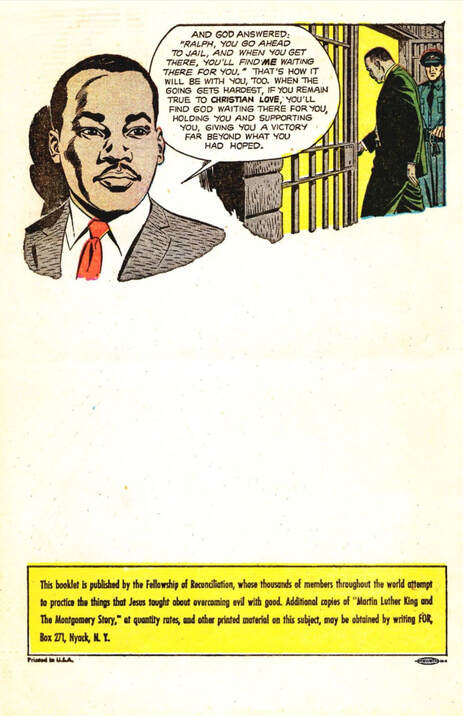 As for The Montgomery Method? In short, 1. Decide your cause; 2. Educate yourself – do not act on rumors or half-truths; 3. Talk to the people concerned – don’t argue – just simply tell them your side and listen to theirs; and finally, 4. Make sure you are ready – seek help from someone with experience and run practice scenarios to face ANY opposition without resorting to violence. As Dr. King said: “In Montgomery we used the nonviolent Christian action to get Jim Crow off the buses. It can be used anywhere though, against any kind of evil.” And truthfully, he’s right!! We ALL could use a bit of The Montgomery Method in our lives. A means of seeing ourselves in our oppressors. In our enemies. Just like the mirror image noted above. It’s work. Much harder than throwing a Molotov cocktail or lighting a cross on fire. And it’s definitely harder than hating someone for their differences. For hate is taught and, from where I sit, quite often misplaced. Simply put: “Nonviolence is the weapon of the strong.” (Mahatma Gandhi) Dr. King practiced this every single day!! He then did his best to teach the world to practice it too and this wonderful little comic, years ahead of its time, is yet another avenue to pass on his message. Especially to children. The language is plain. The artwork is engaging. And the overall story doesn’t vilify anyone. Not even those wretched cross burners. Like the Rosa Parks comic, it simply states what was. What’s even better is the comic itself, directly from FOR, is only $5. It can also be purchased in bulk orders of 21 or more for just $2.50 each. And the profits benefit the Foundation. Plus, the comic itself has been translated into multiple languages including Spanish, Arabic and Farsi. *NICE!!* There’s also a full K-12 Curriculum and Study Guide on the FOR website separating activities by grade ranges and providing notes for teachers. All designed to facilitate not only learning about The Montgomery Story, but its global impact then and now. *AWESOME!!* Lastly, the graphic novel is available everywhere comics are sold, including digitally. I happily have both a print and digital edition. What will you get? And there you have it! Another educational graphic novel proving history can be shared, understood AND heeded without vilification. I learned a lot!! More than expected actually. Because: “Knowledge is the process of piling up facts; wisdom lies in their simplification.” (MLK) And to that I say… YAY COMICS!! Until next time. Summary: “This 16-page comic is a simple but revolutionary account of the 1955 Montgomery Bus Boycott, in which Rosa Parks, Dr. King, and 50,000 others used the power of nonviolence to battle segregation on city buses - and win. First published in December 1958 by the Fellowship of Reconciliation, it went unnoticed by the mainstream comic book industry, but spread like wildfire among civil rights groups, churches, and schools, helping to mobilize a generation to join the global fight for equality - nonviolently. Personally endorsed by Martin Luther King, Jr. himself, over time this comic book has reached beyond his time and place to inspire activists in Latin America, South Africa, Vietnam, Egypt, and beyond... as well as inspiring MARCH, the graphic novel trilogy by the late Congressman John Lewis, Andrew Aydin, and Nate Powell.” |
Archives
May 2024
|
|
© 2012-2025, Nerds That Geek LLC.
All Rights Reserved. |
uWeb Hosting by FatCow

